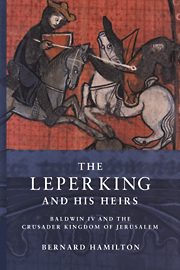Book contents
- Frontmatter
- Dedication
- Contents
- List of illustrations
- Acknowledgements
- List of abbreviations
- Maps
- Genealogies
- Glossary
- Prologue
- 1 The sources for Baldwin IV's reign
- 2 Baldwin's childhood
- 3 The kingdom
- 4 The international status of the kingdom
- 5 The king's minority
- 6 Western aid. William of Montferrat and Philip of Flanders
- 7 The victor of Mont Gisard
- 8 Prince Reynald's initiative
- 9 The dying king
- 10 The heirs of the leper king
- Epilogue
- Appendix An evaluation of the leprosy of King Baldwin IV of Jerusalem in the context of the medieval world
- Bibliography
- Index
7 - The victor of Mont Gisard
Published online by Cambridge University Press: 05 February 2015
- Frontmatter
- Dedication
- Contents
- List of illustrations
- Acknowledgements
- List of abbreviations
- Maps
- Genealogies
- Glossary
- Prologue
- 1 The sources for Baldwin IV's reign
- 2 Baldwin's childhood
- 3 The kingdom
- 4 The international status of the kingdom
- 5 The king's minority
- 6 Western aid. William of Montferrat and Philip of Flanders
- 7 The victor of Mont Gisard
- 8 Prince Reynald's initiative
- 9 The dying king
- 10 The heirs of the leper king
- Epilogue
- Appendix An evaluation of the leprosy of King Baldwin IV of Jerusalem in the context of the medieval world
- Bibliography
- Index
Summary
Philip of Flanders led his army to Tripoli in late September 1177, where they met up with Raymond III and his vassals, together with Roger des Moulins, the master of the Hospital, and most of the Knights of St John from the Kingdom of Jerusalem, as well as a number of Templars, and some 100 knights and 2,000 infantry from the kingdom, perhaps representing the levy from Raymond's principality of Galilee. In November the army moved against Hama. The city was ill prepared for a siege, for the governor was sick and no reinforcements had come from Damascus; nevertheless, the Franks withdrew after four days in response to an appeal from Bohemond III.
Gumushtekin of Aleppo had been overthrown and executed that autumn, but the garrison of Harim refused to acknowledge the new rulers and offered the castle to Bohemond III. According to Michael the Syrian, who was living near Antioch at that time and was therefore well placed to know the truth, the negotiations foundered because Bohemond wished to replace the existing garrison by a Frankish one. He then called on the Franks besieging Hama to help him capture Harim. Harim was strategically important and both Philip of Flanders and Raymond of Tripoli had a personal interest in it. Philip's father, Thierry of Flanders, had helped Baldwin III to recover Harim for the Franks in 1158, and Philip wished to emulate his father's prowess, while Raymond had been taken prisoner by Nur ad-Din in 1164 when attempting unsuccessfully to defend Harim, had been held captive for ten years, and wished to avenge himself by capturing the fortress from Nur ad-Din's son.
Saladin must have been amazed by this turn of events, for he had begun to move his army towards the Frankish border in the hope of deflecting the projected attack on Hama by forcing the Frankish armies to come south to defend Jerusalem. The departure of the Frankish forces to Antioch left the way open for him to invade the Latin Kingdom. Odo of St Amand, master of the Temple, took eighty of his knights to garrison Gaza.
- Type
- Chapter
- Information
- The Leper King and his HeirsBaldwin IV and the Crusader Kingdom of Jerusalem, pp. 132 - 158Publisher: Cambridge University PressPrint publication year: 2000



